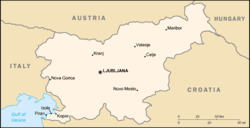Energy in Slovenia
Energy in Slovenia describes energy and electricity production, consumption and import in Slovenia. Energy policy of Slovenia will describe the energy policy in the politics of Slovenia more in detail. Electricity sector in Slovenia is the main article of electricity in Slovenia.
Slovenia is net energy importer. Primary energy use in Slovenia was 81 TWh and 40 TWh per million persons in 2009.[1]

Overview
Slovenia imported 49% of its energy use in 2009.[1]
| Energy in Slovenia[2] | ||||||
|---|---|---|---|---|---|---|
| Capita | Prim. energy | Production | Import | Electricity | CO2-emission | |
| Million | TWh | TWh | TWh | TWh | Mt | |
| 2004 | 2.00 | 83 | 40 | 44 | 13.65 | 15.60 |
| 2007 | 2.02 | 85 | 40 | 45 | 14.41 | 15.92 |
| 2008 | 2.02 | 90 | 43 | 50 | 13.99 | 16.73 |
| 2009 | 2.04 | 81 | 41 | 40 | 12.45 | 15.15 |
| 2012 | 2.05 | 84 | 44 | 41 | 13.97 | 15.26 |
| 2012R | 2.06 | 81 | 41 | 42 | 13.94 | 14.63 |
| 2013 | 2.06 | 80 | 41 | 38 | 14.08 | 14.34 |
| Change 2004-09 | 2.0 % | -2.8 % | 2.9 % | -9.0 % | -8.8 % | -2.9 % |
| Mtoe = 11.63 TWh, Prim. energy includes energy losses [3]
2012R = CO2 calculation criteria changed, numbers updated | ||||||
¨
Electricity
In 2008, electricity use per million person in Slovenia was 6.1 TWh compared to Spain 6.0 TWh. or Britain 5.7 TWh.[1]
Renewable energy
In Slovenia's forecast, renewables satisfy about 40% of the country’s electricity consumption in 2020. Slovenia is the EU country with the smallest forecast penetration of wind power in 2020: 1.3% of electricity consumption, while the Irish action plan shows wind meeting over 36% of the country’s electricity demand. Slovenia has intention to cover its EU renewable energy obligations 6.1TWh (2020) mainly with hydro power 5.1 TWh and biomass 0.7 TWh. According to EWEA’s calculations by 2020 wind could cover 6% - 9% of electricity demand. The newly adopted feed-in tariff limiting support to projects of 5 MW and under may be hindering perspectives for wind power development.[4]
Climate change
1990 emissions were 20Mt CO2 eqKyoto protocol target is reduction of 2Mt (-8%).[5]
See also
| Wikimedia Commons has media related to Energy in Slovenia. |
References
- 1 2 3 IEA Key energy statistics 2010 Page: Country specific indicator numbers from page 48
- ↑ IEA Key World Energy Statistics Statistics 2015, 2014 (2012R as in November 2015 + 2012 as in March 2014 is comparable to previous years statistical calculation criteria, 2013, 2012, 2011, 2010, 2009, 2006 IEA October, crude oil p.11, coal p. 13 gas p. 15
- ↑ Energy in Sweden 2010. Facts and figures. The Swedish Energy Agency. Table 8 Losses in nuclear power stations Table 9 Nuclear power brutto
- ↑ EU Energy Policy to 2050 EWEA March 2011
- ↑ Wind energy and EU climate policy Achieving 30% lower emissions by 2020 EWEA October 2011 p. 39
| ||||||||||||||||||||||||||||||||||||||
| ||||||||||||||||||||||